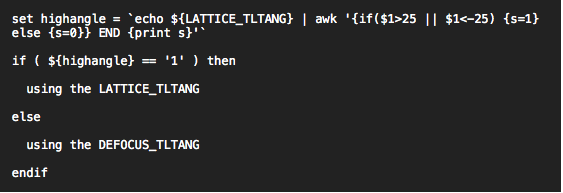Tiltgeometry
Variables, defining the tilt geometry
TLTAXIS: X-axis -> Tilt axis (on image) [TLTAXIS]
Defines the angle from the X-axis to the tilt axis. This is measured on the micrograph. The value is given in grad, and is measured counter-clock wise from the X-axis upwards. TLTAXIS has nothing to do with the 2D crystal.
TLTANG: Tiltangle of sample support [TLTANG]
Defines the tilt angle of the sample (the carbon film) in the microscope during data collection, in grad. TLTANG has nothing to do with the 2D crystal.
TLTAXA: Tilt axis -> A* vector (on 2D image, as projection of 3D vectors) [TLTAXA]
Defines the angle from the tilt axis to the tilted A-star axis of the 2D crystal, when measured on the micrography. A-star is the first lattice vector in the real-space image, in grad. TLTAXA is related to the 2D crystal, it defines how the 2D crystal was laying on the carbon film with respect to the coordinate system.
TAXA: Tilt axis -> A* vector (on crystal sample, in 3D space) [TAXA]
Defines the angle from the tilt axis to the A-star axis of the 2D crystal, when measured on the carbon film. (Well, it is too late to measure that on the carbon film, but TAXA can be calculated from the other values). TAXA is therefore quite similar to TLTAXA, but it is usually larger or equal to TLTAXA, since TLTAXA is the projection of the TAXA, measured in grad.
TANGL: Tiltangle for crystal (=TLTANG*AisAbove*SignTLTAXA*Hand) [TANGL]
Defines the tilt angle, but this time from the point of view of the 2D crystal. The only difference is (or can be) the sign: TANGL has the same value and sign as TLTANGL, if A is above the tilt axis, TLTAXA is positive, and the lattice is a right-handed lattice (counter-clockwise definition of A and B). If either of these three factors is different, then the sign of TANGL changes with respect to TLTANGL. If two of these factors are different, then TLTANGL and TANGL have the same sign. If three are different, then the sign is again different.
TLTAXIS: Xax→Tiltax (on neg.) [grd]>
TLTANG: Tiltangle (on neg.) [grd]
TLTAXA: Tiltax→A* (on neg.) [grd]
TAXA: Tiltax→A* (sample) [grd]
TANGL=(AISABOVE*SIGNTLTAXA*HAND) * TLTANGL
Lattice distortions give the tilt geometry only for larger tilt angles, e.g. larger than 30 degrees. For smaller angles, the method is not sensitive enough, and slightest distortions are immediately interpreted as some tilt. Usually, I would trust the defocus gradient for small tilt values, and the lattice distortions for larger tilts. That is also in those scripts, and looks in 2dx_getLattice.script like this:
